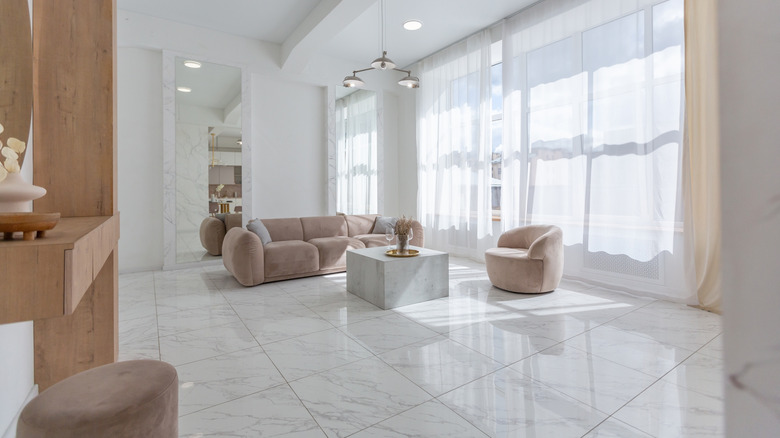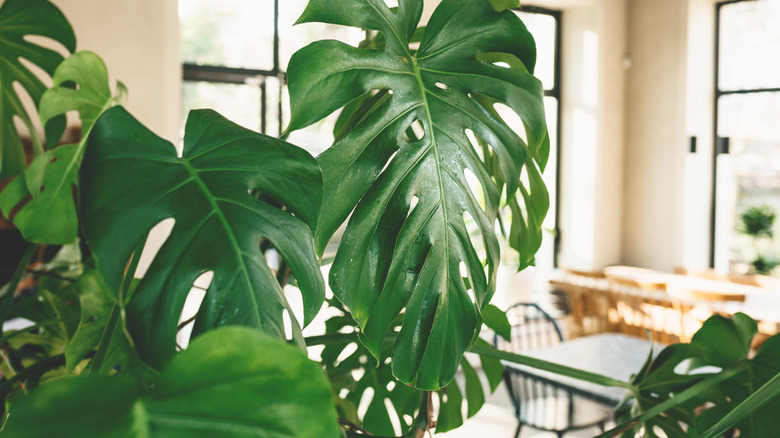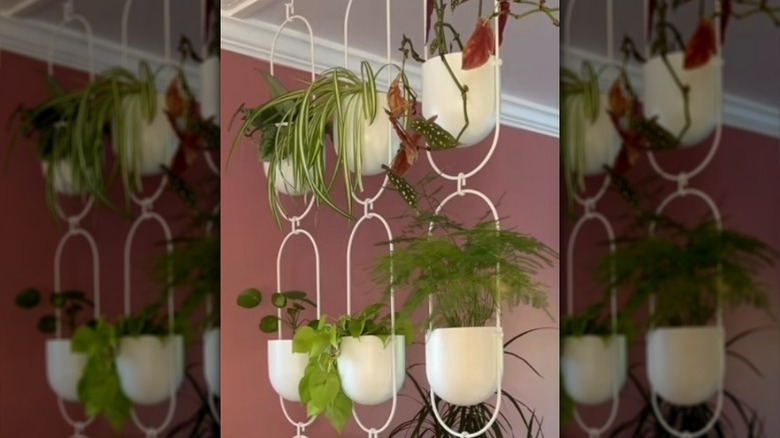Break Up An Outdated Open Floor Plan With A Lively Solution
We may receive a commission on purchases made from links.
Open floor plan living has its perks. It's easier to summon the household when supper is ready, there are fewer objects to stub your toes on, and nothing stops glorious light from flowing through the entire space. But if you're looking for better sound control and a sense of cozy privacy without building walls, consider a living solution — indoor plants!
With some creative arranging, the right plants can be used as effective room dividers while still allowing soft light to filter through. Not only that, but plants improve the air quality in your home, reduce noise, and bring personality and life to a space. While you'll have to give them more attention than you would a standard partition, there are many perks that make them worthwhile. Apart from looking gorgeous, caring for houseplants can be a soothing way to lower stress levels and remind us of the simple joys of life.
When choosing plants for your living divider, consider how much light the area gets. If the area you're dividing isn't near a window, pick indoor plants that don't need much sun to survive. To keep your divider growing and healthy (it's an important part of your decor, after all), keep some plant food on hand, such as the Organic Plant Magic fast-acting fertilizer and plant food for all indoor potted houseplants.
Dividing your space from the ground up
Before deciding what kind of arrangement would work best, analyze the space. For smaller areas, using a single large feature plant may do the trick. Look for something that fills the space with large leaves, such as a Swiss cheese plant, dumb cane, or giant elephant ear. If you prefer the look of bushy plants with smaller leaves, try a golden cane palm or pick out a fern that appeals to you. Use a pot that suits the decor of the room, as it will be part of the overall look.
If you have sufficient floor space between the two areas you'd like to separate, invest in a rectangular planter box. Fill it with houseplants perfect for growing indoors. Aim for plants that grow tall, such as a money tree, a rubber tree with its glossy green leaves, or a Hawaiian Ti plant for a pinkish tinge. Pair your planter with a plant cage, like the MYMULIKE 6-foot garden trellis, and add climbing plants.
If you're looking for a flexible solution, invest in a clothing rail on wheels. Hang plant baskets alternating between bushy ferns, trailing plants, and patterned beauties, such as a nerve plant. Match the clothing rail to the room's aesthetic, choosing a sleek metallic look for modern interiors, antique brass with curled ends for a vintage vibe, or black for an industrial look. Clothing rails are easy to move around and can be repositioned as you wish.
Minimal floorspace? Suspended solutions are your answer
Even if you don't have much floor space to play with, you can still create a living privacy screen. As pictured above, TikToker @josue_taco used multiple suspended hanging baskets to divide two areas. They incorporated many types of plants, including some trailers, climbers, and ferns. The overall effect is balanced by the uniformity of the hanging system, which creates a backdrop of order to show off the greenery perfectly.
For those who'd prefer not to be drilling into the ceiling, invest in floor-to-ceiling suspension shelves that use tension rods to hold the shelves in place. If you've used a tension rod to tame your fridge and cabinet chaos before, you'll know how handy they are. When it comes to splitting a space, this is a hassle-free solution that is semi-permanent. While it may be tempting to load up the shelves with books, trinkets, and other clutter, resist the urge! Remember, your goal is to create a living partition.
If your sofa is acting as a divider between the living and dining spaces, you need only to block off the area between the backrest and the ceiling. An easy solution is to use suspended shelves, such as the DIYHD ceiling-mounted shelf with a U-shaped plumbing pipe bracket. Pay close attention to the manufacturer's weight guidelines to prevent overloading the shelf. If necessary, opt for lighter plastic pots instead of ceramics for adding your greenery.


